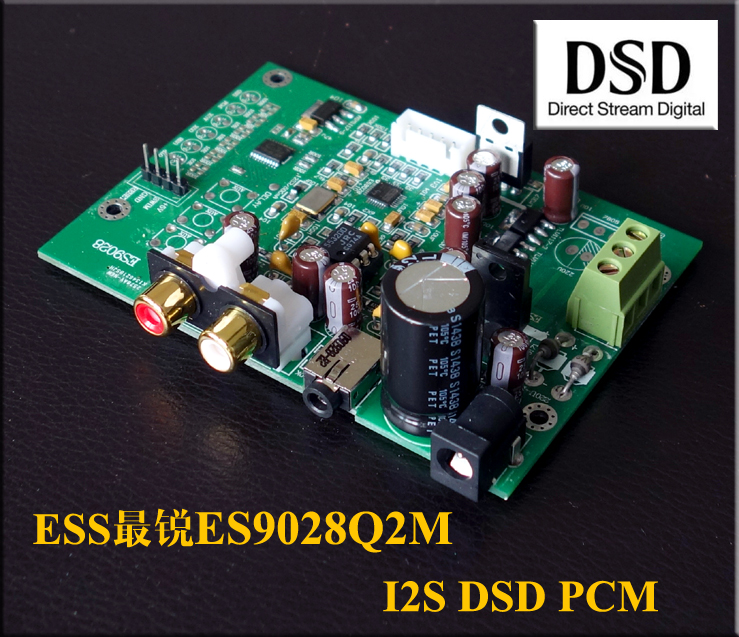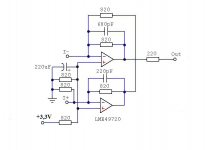ES9018K2M I2S ES9018 IIS-32bit 128 256 384K /DSD64 Input Decoding Board | eBay
Amazing and cheap boardThe original board shows the third harmonic of the 1kHz 0dB at around -87dB. After the buffer was replaced with this one simple schematic with the +/-15V supply :
http://content30-foto.inbox.lv/albums/v/viccc/ES9018K2M/ESbuf.jpg
Now the 1kHz 0dB looks that:
http://content30-foto.inbox.lv/albums/v/viccc/ES9018K2M/1kHz0dB.jpg
1kHz -3dB:
http://content30-foto.inbox.lv/albums/v/viccc/ES9018K2M/1kHz.jpg
The mix of 19kHz -6.1dB and 20kHz -6.1dB:
http://content30-foto.inbox.lv/albums/v/viccc/ES9018K2M/19kHz-20kHz.jpg
All this was played from the wav files 44.1kHz 16 bit under WXP>foobar USB Asio out>E-MU0202>I2S>ES9018K2M
Also the the ES9018K2M runs from the E-MUs crystal oscillator 22.579Mhz.
Victor
After measuring disappointing results, I was looking into how to get the best out of exactly the same board, more particularly starting with finding the particulars of this DAC chip. No specsheet to be found.
Victor to the rescue with this ready made and tested solution. Thanks for posting! I love the simplicity.
What I wonder though is why the upper opamp has a 680pF pole setting C in the feedback loop, and the lower one a 220pF? This might not be correct. I suppose they should both be 680pF (at least).
Best,
Paul
What I wonder though is why the upper opamp has a 680pF pole setting C in the feedback loop, and the lower one a 220pF? This might not be correct. I suppose they should both be 680pF (at least).
Best,
Paul
Thanks for the response, Paul.
Signal from the lower opamp goes thru the upper opamp and gets it's pole. Ideally would be, when the lower opamp has no pole, but in reality it is impossible. Lower opamp needs a capacitance shunt in feedback for the stability in real conditions. Maybe the 220pF capacitance can be lowered.
The overall measured result is very good (almost perfect), and one of the main advantages is that the both opamps run in the inverted mode when the distortion figures are low as possible.
All the best,
Victor.
Last edited:
Listening now.
First impressions... I am quite surprised... My Diyinhk 9018k2m with 3x custom power supplies is bested by this 9038q2m using a single 15+-0-15- supply. (plenty of opportunity here for upgrading )
It does not have the 'clinical' presentation I associate with ESS chips... and seems warmer and fuller yet without sacrificing detail.
Resolution and soundstage is noticeably better than the 9018k2m .
I have wired a 50k audio taper pot and can adjust volume. Not a big range but enough to use as a 'digital controller' direct to a power amp.
Using a rotary switch to change inputs. No switching noises ! Very smooth operation.
Will try switching filters next but can't see the need really. Who changes filter on a track by track basis? .
I would rather listen to one for a week then try another and eventually settle on a preferred filter then leave it jumpered.
Inputs tested ...Usb to i2s, optical, and coax all work.
Downsides ?
... so far no direct i2s driver to be found..:-(
I am using a usb to i2s (raspberry pi player) interface and this works ok mostly... lock not achieved unless the dac is switched on while the Pi boots. If it is on first the Pi does not recognise it.
If anyone finds a dtoverlay for this I would be most interested...
Is there any way you'd be able to compare it with an Odac? or a Dac1/Dac2/Dac3? And do you/anyone here have measurements for this DAC board? I'd like to purchase but I would like a truly reference/studio grade dac for cheap (ie. <+/0.1db freq response, very low noise, etc.)
And do you/anyone here have measurements for this DAC board? I'd like to purchase but I would like a truly reference/studio grade dac for cheap (ie. <+/0.1db freq response, very low noise, etc.)
Standard, it measures a bit disappointing, mainly 3rd order, but still pretty good. Modded, it should be really good. Victor showed measurements. I am working on a board now and will show pictures and results when done.
Hi, I just purchased the X4000 doc from Dealextreme in the US for £42 incl shipping to the uk. I attached it to a RPI3 loaded it with volumio2 and it worked first time. I was unable to try it with Moode 4.0 as I don't have any IT technical skills to make the image (can anyone help please if I supply an sd card ?!!!) but can honestly say it sounds fantastic playing through an arcam a19 and spender s3/5r.
Hi, I just purchased the X4000 doc from Dealextreme .....
Did you mean SupTronics X4000 Expansion Board for Raspberry Pi 3?
start with modding ?
this is the "old" one DX7 without the s (DX7s is the new one)
NEUESTE RICHT DX7 USB DAC ESS9018K2M * 2 XMOS TPA6120 * 2 opa2134 DSD 32BIT/384 KHz AUDIO Verstarker ausgewogene Decoder Kopfhorerverstarker in NEUESTE RICHT DX7 USB DAC ESS9018K2M * 2 XMOS TPA6120 * 2 opa2134 DSD 32BIT/384 KHz AUDIO Verstarker ausgewogene Decoder Kopfhorerverstarker aus Verstarker auf AliExpress.com | Alibaba Group
cu
chris

this is the "old" one DX7 without the s (DX7s is the new one)
NEUESTE RICHT DX7 USB DAC ESS9018K2M * 2 XMOS TPA6120 * 2 opa2134 DSD 32BIT/384 KHz AUDIO Verstarker ausgewogene Decoder Kopfhorerverstarker in NEUESTE RICHT DX7 USB DAC ESS9018K2M * 2 XMOS TPA6120 * 2 opa2134 DSD 32BIT/384 KHz AUDIO Verstarker ausgewogene Decoder Kopfhorerverstarker aus Verstarker auf AliExpress.com | Alibaba Group
cu
chris
Last edited:
There is their new product used ES9028Q2M:

I am currently modding this board, they are very cheap on eBay. The PCB layout away from the IC is terrible (aka bits have been bolted on), whoever made it couldn't give a toss. Luckily though it still sounds wonderful. Around the I.C it's not bad, there's plenty of decoupling capacitors.
The input side has a power transistor with a resistor/cap delay before power on. Perhaps the idea was to soft start power to the OP-Amp but it doesn't work, the thump is still there. All this "feature" does is waste a bit of power in the BLT.
I then removed the 5V chip on the otherside of the board to make sure the multiplexing chip (poss i2c encoder?) wasn't doing anything critical. That done I cut that side of the board off. Regrettably I now have low volume. There's two 100R resistors which I'm certain have something to do with it however nothing I've tried works. The alternative is to modify the 6.2K resistors feeding the op-amp, yet the I2S volume hits a ceiling quite early so I believe there's a soft volume at play.
If anyone has the restricted datasheet I'm keen to learn how to set the default output level. Those 100R's are connected to pin 31 & 32.
Cheers!, Andrew
I tried the I/V of victor, resistor value changed from 820 to 680, non inverting input connected to ground, i use diyinhk board which use +/-12v rail. Now i get 1.41V DC at output, why does this happened? with the original lpf, the output is held at 0V.
You can try this modified schematic for to get 0 DC at output :
Attachments
Please look this old post #151:Has anyone taken measurements after adding an I/V converter?
Chinese ES9018K2M I2S DAC
- Home
- Source & Line
- Digital Line Level
- Chinese ES9018K2M I2S DAC


